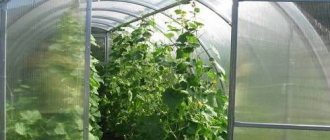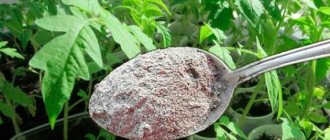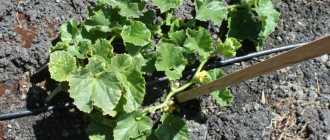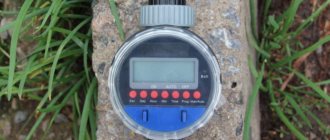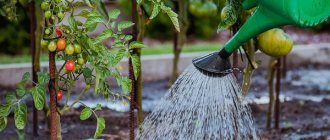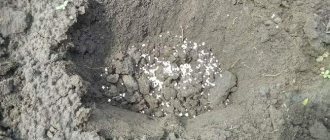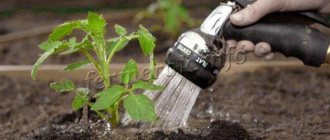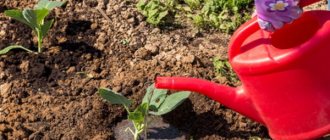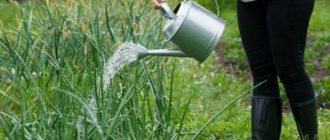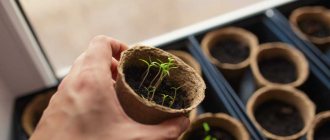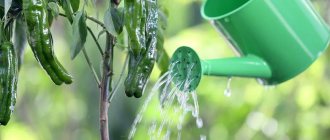General rules for watering zucchini
The practice of cultivating zucchini has made it possible to develop a number of general recommendations:
- Watering is carried out in the evening or morning hours (during minimal solar activity).
- Watering is done at the root, and it is advisable to use a sprayer. Moisture should not get on the green part of the plant.
- It is recommended to ensure that the soil moisture depth is at least 40 cm, avoiding waterlogging or lack of moisture.
- When moistening, it is necessary to take into account the composition of the soil: sandy or sandy loam soil is watered more often, clayey and loamy soil - less often.
- Water must meet agricultural requirements in terms of temperature and chemical composition.
- During the period of flowering and fruit growth, the frequency of watering and the volume of moisture are increased, while simultaneously using fertilizing.
- It is advisable to use mulch after loosening. The means of choice are mixtures of straw, sawdust, peat and humus. The recommended layer thickness is 5-7 cm. The use of mulch is especially important during the period when the active growth of zucchini begins.
Common Mistakes
Watering zucchini seems like a simple and straightforward procedure. However, an inexperienced gardener can make mistakes, thereby causing harm to the plants:
- Unsuitable temperature. Cold water for watering zucchini is a strong “stress” for plants, causing the flowers and ovaries to fall off, and the fibrous roots to die. Hot temperatures significantly slow down the development of plants.
- Too frequent and/or excessive watering. In a garden bed that has been turned into a “swamp,” the zucchini will almost certainly become infected with rot.
- Drops of water falling on the leaves. If this happens regularly, they turn yellow and sunburn appears.
- Watering zucchini during the day, during maximum solar activity. Water evaporates very quickly, without having time to wet the soil. The soil dries out even with regular moistening in the required amount.
- Neglect of loosening and weeding. They are carried out the next day after watering the zucchini. Otherwise, the soil “bakes” into a hard crust into which water cannot be absorbed. It also interferes with normal air exchange. Weeding is necessary to control weeds, which are serious “competitors” for zucchini in the fight for water and nutrients.
An incorrectly chosen method of watering zucchini will almost certainly lead to rotting of the plants and fruits.
Important! It is highly recommended to mulch beds with zucchini. This procedure protects the soil from overheating, minimizes the likelihood of soil being “washed away” from the roots, and saves time on loosening and weeding.
Correct watering of zucchini in open ground at different stages
The specifics of watering vary depending on the different phases of plant development. In addition, the characteristics of the soil composition and weather conditions are taken into account. At air temperatures of 35°C and above, the frequency of watering increases to once every three days. In rainy weather, there is no need for additional moisture.
The volume of moisture is calculated based on the following indicators:
- the required depth of moisture depending on the growing season;
- granulometric composition of the soil and its initial moisture level;
- selected irrigation method.
When planting zucchini seeds
Sprouts appear 7-10 days after sowing. All this time, the soil should be constantly moistened.
When planting zucchini seedlings
After planting in open ground, seedlings begin to be watered with warm water 3-4 days after rooting. It is recommended to use a watering can, spending 2-3 liters on each plant. Watering should be at the roots, and its frequency should be 1 time every 4-5 days. To increase the absorbent properties of the soil, it is advisable to hill up the seedlings, as well as sprinkle them with peat or soil. It is useful to use mulching with peat with humus or straw. In hot weather, watering and mulching are combined.
During flowering
After the formation of buds, watering must be done twice a week, using an average of 8-10 liters per watering. The weather and soil conditions must be taken into account. Water should flow to the roots of the plant, adequately moistening them.
During the fruiting period
Approximately 2-3 weeks after the start of flowering, during the period of ovary growth, the frequency of watering is increased, as is the amount of moisture consumed. To moisten the soil to a depth of 30-40 cm, a bucket of water (8-10 liters) should be poured under the bush twice a week. However, it is necessary to take into account weather conditions and make allowances for them.
Features of watering in hot weather
It is better to irrigate plants in the morning (from 6-00 to 9-00) or evening (after sunset) under a bush. Avoid getting moisture on the leaves. The water temperature should be room temperature.
Abundance of watering in normal weather
On average, 12 liters of warm and settled water per 1 m2 is required, which corresponds to 2-3 liters per mature bush. Watering is done every week, including the flowering period.
Watering with fertilizing
Cultivation of zucchini requires constant application of organic and mineral fertilizers. The first fertilizing must be done two weeks after planting the seedlings in the ground.
During fruit ripening, preference is given to those products that are used for foliar feeding. Irrigation of foliage is recommended in the evening hours after sunset.
Water requirements
Water for watering zucchini must meet several criteria:
- "Softness". Tap water straight from the tap is absolutely not suitable for irrigation. It contains calcium, fluorine, and chlorine compounds, to which zucchini react very negatively. To soften, tap water is allowed to settle for about a day, waiting for a grayish or whitish flaky sediment to form. Gardeners also practice “freezing out” harmful impurities. Spring, well, filtered, bottled drinking water does not require preliminary “preparation”.
- Temperature 15-20 °C. The critical minimum for watering zucchini is 10 °C. The colder the water, the worse the roots absorb it, and plant development is slower. In addition, they can give a “shock” reaction to such watering, dropping flowers and fruit ovaries en masse. Too hot water promotes the activation of pathogenic microflora, increasing the risk of zucchini becoming infected with fungal and other diseases.
Most often, gardeners store water for irrigation in barrels and other containers, while simultaneously heating it in the sun
. Important! Rainwater is good for watering zucchini. But only if there are no industrial enterprises near the place of its collection.
Methods for watering zucchini in open ground and greenhouses
The choice of irrigation methods and methods is determined by a set of conditions:
- natural: climatic (wind rose, precipitation, temperature and humidity);
- soil (moisture absorption rate, filtration coefficient, salinity level);
- relief;
- hydrological (depth of groundwater, level of its mineralization, degree of soil drainage);
- biological (duration of the growing season, specific ontogenesis of the green part of the plant and its root system);
- water management;
Requirements for choosing a watering method
Irrigation methods should include the ability to:
- high labor productivity;
- uniform moistening of arable land;
- widespread use of mechanization in the process of caring for plant crops;
- rational consumption of water resources.
Watering with a watering can and hose
Manual watering using a watering can is used to irrigate small areas. When watering the green part of the plant, use a nozzle.
Watering from a hose requires the use of a spray nozzle. When cultivating zucchini, use water at room temperature. Irrigation is recommended to be done in the evening.
Dosed watering using plastic bottles
First, prepare the equipment. The bottom is cut out in the bottles, after which 4-6 holes are made in the caps using an awl, after which:
- At a distance of 20 cm from the zucchini, a hole 10-12 cm deep is dug, into which the bottle is placed neck down.
- The bottle is tilted at an angle of 45° and filled with water.
Watering with a “wick”
The technique involves the use of any containers (buckets and basins), which are filled with water and installed at a distance of 1.5-2 m from each other. A tourniquet is formed from a piece of fabric, one end of which is placed in a container, and the other is buried in a ridge to a depth of 10-12 cm.
Jet watering with a hose
The method is economical. Holes are formed in the hose so that they are located opposite the growing zucchini, after which the hose is buried to a shallow depth and connected to the water supply system.
Subsoil irrigation
Refers to industrial irrigation methods. Steel or plastic pipes with holes made in them are buried in the row spacing to a depth of 30-40 cm, after which the water supply is connected.
Sprinkling
The industrial method is used on large farms. This type of irrigation requires the use of complex and expensive equipment. The principle of its operation is to supply water through a pipeline under significant pressure, as a result of which small drops are formed in the nozzles, dissipating in the form of fog. The advantages of sprinkling include the relatively small consumption of water and the uniformity of its distribution. In addition to the high cost, the disadvantages include significant evaporation of liquid.
Gravity
Also applies to industrial irrigation techniques. Includes two varieties:
- estuary - the territory of the site is completely flooded;
- furrow - water flows between rows.
The advantages of the technique include its low cost and relatively high productivity. The disadvantages are uneven water supply and significant overconsumption.
The limitations of the estuary method include the formation of a crust in the soil layer.
Drip
Watering is possible using tapes and drippers.
Using tape
The device most often consists of a hose tube with a diameter of 1.6 cm and a wall thickness of 0.2 mm. This diameter is considered optimal because it makes it easier to find connectors. The wall thickness is optimal in terms of price-quality ratio. In appearance, the folded tube resembles a ribbon, which is what gave the technique its name.
Watering with drippers
In gardening, drippers are devices equipped with tubes for supplying water.
They are conventionally divided into:
- adjustable - the design allows you to control water flow;
- uncompensated - the water supply is uneven, usually the beginning of the bed is moistened more than its end (recommended for flat surfaces);
- compensated - humidification is carried out in doses (a valve-membrane mechanism is provided).
The effect of excess moisture on the plant
Excess moisture will lead to rotting
Zucchini needs moderate watering so that water does not stagnate under the plants. Otherwise, oxygen will not enter the soil, which is why the root hairs will begin to die. Excess moisture when watering zucchini will also lead to the following consequences:
- spread of fungal diseases;
- reducing the sugar content of zucchini;
- the rapid growth of culture in the early stages of development and oppression in later ones;
- rotting of fruit tips.
To prevent moisture stagnation during heavy rains, it is worth making grooves to drain liquid. Some gardeners build canopies over the site.
